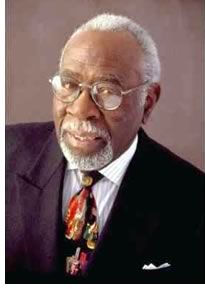

04/2005
Fund honors RPMI’s 50 years of practice
 by Heather Livingston
by Heather Livingston
Robert P. Madison, FAIA, has faced challenges throughout his lifetime to overcome prejudice and setbacks. A man who has never yielded to the obstacles set before him, he now is making the path easier for those who will follow. To celebrate the 50th anniversary of Robert P. Madison International (RPMI), he established the Robert P. Madison Scholarship in Architecture for African American students with a GPA of at least 3.0 and who are accepted or enrolled as an undergraduate in an accredited Pell-eligible post-secondary educational institution with a declared major in architecture.
Born in 1923, Madison witnessed his father, who held a civil engineering degree from Howard University, repeatedly denied the opportunity to practice in his field. After serving honorably in Italy during World War II, Madison himself was denied admission to the Western Reserve University School of Architecture because “we have never had a Negro attend this school, and I doubt that we ever will.” After returning to the school vested in his Army uniform, Purple Heart, and three battle ribbons, he was finally accepted. In 1948, Madison was the first African American to graduate from Western Reserve University School of Architecture, winning its Jansen Thesis Award and honorable mention for the Prix de Rome. Still, no architecture firm would hire him; some wouldn’t even let him complete an application. Eventually, he was hired to practice without pay. In 1950, Madison became the first African American to be registered to practice architecture in the state of Ohio.
Academic excellence
In 1951, Madison was accepted into the Harvard University master’s
program, where he studied under the legendary Walter Gropius. Typical
of Madison, he excelled at Harvard and graduated as president of his
class in 1952. Yet he was not interviewed by any architecture firms upon
graduation. He subsequently accepted the Fulbright Scholarship to study
at Paris’s L’Ecole des Beaux Arts. When he returned, he accepted
a faculty position at Howard University.
In 1954, unable to secure a $500 loan from a bank, Madison founded the first African-American-owned architecture firm in Ohio—the tenth in the U.S. To help support his ambition, his wife Leatrice returned to teaching elementary school, his brother Julian worked at NASA, and his mother Nettie worked at the IRS. His practice began with remodels and small jobs such as basements, porches, and attics. Those first few years saw Madison designing principally for A.M.E. churches and African-American-owned endeavors. Eventually, others began to take notice. Along the way there were many firsts for an African American architect: in 1965, he became the first to win a competition to design a U.S. Embassy, in Dakar, Senegal, West Africa; in 1968, he was the first to design a branch office for a major corporation; in 1987, he became the first African American architect to design a major building for the state of Ohio. In addition, in 1969, he became the first African American to serve on the Board of Trustees at Case Western Reserve University, the school that once had denied him admission.
Myriad accolades
Over the last decade and a half, Madison has finally garnered the recognition
he deserves. In 1989, he received the Distinguished Service Award from
Case Western and the Distinguished Firm Award from Howard University.
In 1994, RPMI received AIA Ohio’s Gold Medal Firm Award. Madison
received AIA Ohio’s Gold Medal Architect’s Award in 1997.
And, in 2002, he received the AIA’s Whitney Young Jr. Award for
his profound social impact on the profession. Throughout his 50 years
in practice, Madison’s firm has hired and trained nearly 200
aspiring African American architects, engineers, and planners.
The genesis for creating a scholarship fund for African American youth came a few years ago when he was designing a jail. Madison recalls, “Here were all these inmates, many of them young African Americans, 18 or 20 years old. They should have been in college learning a useful profession, something that would give them satisfaction and a good living, instead of heading down this tragic road.” Deeply troubled by the trend among young African Americans to reject pursuing an education as “acting white,” he hopes to give them a chance to realize that an education in architecture can be rewarding and feasible. “It breaks my heart to see so many African American youths caught up in the notion that the only place there is any chance for them to make something of themselves is a basketball court,” he says. Citing a surprising statistic uncovered by Henry Louis Gates Jr., PhD, the head of Harvard’s African American Studies, that there are only 1,200 African American professional athletes in all sports in the U.S., Madison says, “I want these young people to know that there are much more realistic opportunities out there and that there are resources to help them realize their dreams.”
Copyright 2005 The American Institute of Architects.
All rights reserved. Home Page ![]()
![]()
 |
||
AIArchitect thanks Dennis J. Dooley of Cleveland for his assistance with this article. As part of a 2004 AIA Convention Resolution to explore the realities of diversity in the profession of architecture, the AIA has commissioned Holland & Knight Corporate Diversity Counseling Group to conduct a survey to establish a base line of current demographics and attitudes within and outside the profession. If you have not already answered the survey, and would like to, click here. Nearly $60,000 has been raised for the Robert P. Madison Scholarship in Architecture, a special fund of the Cleveland Foundation. Awards will range from $1,000 to $3,000. Completed applications are due April 30, 2005, with the first recipients announced in early June. For more information, or to contribute to the fund, visit the Cleveland Foundation.
|
||